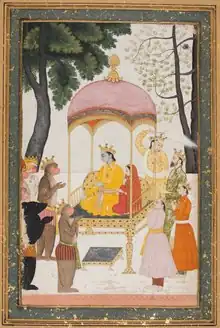Ramanama
The ramanama (Sanskrit: रामनाम, romanized: rāmanāma, lit. 'the name of Rama') is the Hindu practice of ritually chanting the name of the deity Rama, an avatar of Vishnu.[1] Rama's name is often chanted or sung within several traditions of Hinduism in the form of a japa, or meditative repetition.[2]

Literature
In the Ramacharitamanasa, the ramanama is regarded to offer strength to Hanuman.[3]
In Guru Granth Sahib, the sacred book and current guru of Sikhism, the name of Rama is the second most commonly used name for the formless God after the name Hari.
In the Vishnu Sahasranama, a popular verse indicates the significance of the name of Rama:[4]
Śrī rāma rāma rāmeti
rame rāme manorame
sahasranāma tat-tulyaṁ
rāma-nāma varānane
I rejoice in Rama, he who has a beautiful face and is pleasing to the mind. The name Rama is equivalent to the thousand names (of Vishnu).
In popular culture
The mantra was often used by Mahatma Gandhi.[5]
Neem Karoli Baba encouraged the constant repetition of "Ram" in order to become closer to God, saying: "By taking the name of Ram, everything is accomplished."
A popular mantra is Sri Ram Jai Ram Jai Jai Ram (often prefixed with "Om"), which was popularized in western India by Samarth Ramdas.
"Ramanama satya hai" (transl. The name of Rama is the truth) is a Hindi phrase commonly chanted by Hindus while carrying a dead body to be cremated.[6][7]
Tyagaraja, a composer of Carnatic music, mentioned the ramanama in his compositions.[8]
Swami Ramdas is said to have attained nirvana through the constant repetition of "Om Sri Ram Jai Ram Jai Jai Ram". He established Anandashram, where this mantra is sung continuously from morning to night.
See also
References
- Ranganathananda, Swami. The Spiritual Life of Indian People. Advaita Ashrama (A publication branch of Ramakrishna Math, Belur Math). p. 18.
- Glucklich, Ariel (2008-05-09). The Strides of Vishnu: Hindu Culture in Historical Perspective. Oxford University Press, USA. p. 193. ISBN 978-0-19-531405-2.
- Ludvik, Catherine (1994). Hanumān in the Rāmāyaṇa of Vālmīki and the Rāmacaritamānasa of Tulasī Dāsa. Motilal Banarsidass Publ. p. 50. ISBN 978-81-208-1122-5.
- Devananda, Vishnu (1999). Meditation and Mantras. Motilal Banarsidass Publ. p. 67. ISBN 978-81-208-1615-2.
- Vandana, Sister; Mataji, Vandana (September 1995). Nama Japa: The Prayer of the Name. Motilal Banarsidass Publishe. p. 114. ISBN 978-81-208-1286-4.
- Michaels, Axel (2016). Homo Ritualis: Hindu Ritual and Its Significance for Ritual Theory. Oxford University Press. p. 147. ISBN 978-0-19-026263-1.
- Ayodhya Imbroglio. Ashish Publishing House. 1995. p. 90. ISBN 978-81-7024-679-4.
- Jackson, William Joseph (1994). Tyāgarāja and the Renewal of Tradition: Translations and Reflections. Motilal Banarsidass Publ. p. 115. ISBN 978-81-208-1146-1.